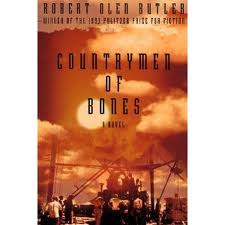Butler, Robert Olen. (1983). Countrymen of Bones. New York: Holt.
There are two protagonists in this story set in the New Mexico desert at the end of World War II. Darrell is an archeologist digging up the skeleton of an ancient king. Lloyd works nearby at the Manhattan project, preparing to test the first atomic bomb. They both fall in love with a dark-eyed beauty, Anna. Lloyd has the upper hand, you would think, since he is with the bomb people and can order Darrell to clear out of the desert, keeping Anna for himself. It doesn’t quite work out that way.
I was interested in reading something by Butler, who won the Pulitzer Prize ten years after this novel, because I had read his book of advice on how to write fiction, “From Where You Dream.” This review is as much about that book as about Countryment of Bones, which left me cold. In the how-to book, Butler said an author should imagine himself or herself into the interior of each character by going into a dreamlike trance. By that method, he said, you can create realistic, compelling characters. I wanted to see how he did that in practice.
In Countrymen, the narrator (third-person, ranging from omniscient to close), tells the reader what the characters are feeling, sensing, and thinking, just as Butler advised. There are a lot of statements like, “He felt angry now…,” “Lloyd wanted…,” “Darrell felt himself tremble and wanted to touch Betty…”
Fiction writers are forever advised to force characters to make choices that reveal feelings, thoughts, impressions. Butler does that, but he also describes the character’s interior as if it were landscape. Why does he think it’s better to report that Darrell wanted to touch Betty, rather than have Darrell reach out toward Betty’s smooth white shoulder but hesitate then pull his hand back without touching her? By both methods, we know Darrell wanted to touch Betty.
With Butler’s method, there are no descriptions for the sake of description. Instead, all descriptions are the musings of a motivated character who has a point of view and a reason for noticing the scenery. That infuses the scenery with the emotionality and intentionality of the character and avoids “dead” description. The technique is sometimes called “the objective correlative.” For example, instead of “Two soldiers were carrying a large box,” we have, “Lloyd could see that two soldiers were carrying a large box.” In the first case, they are just abstract soldiers in an abstract scene. In the second case, we are seeing the soldiers through Lloyd’s eyes. Is that better? Maybe it is more intimate. The story is about the characters, after all. Why leave the characters for even an instant?
On the other hand, it can be odd when the technique is carried out relentlessly. Why say that “Darrell felt himself tremble?” How is that different from “Darrell trembled?” Insisting on Darrell’s point of view actually creates distance from the character. A person does not “feel themselves tremble.” They just tremble. So Butler’s technique, when used assiduously, produces clunky results sometimes.
Butler also commits the deadly sin of “head-hopping.” That’s where the narrative point of view (POV) jumps between characters within the same scene. The rule in modern fiction is that each scene is narrated from only one characters’ POV. Butler breaks the rule with skill. The abrupt shifts in POV were jarring to me, but maybe not to most readers.
I have started using Butler’s technique of dream-trancing to imagine myself into the interiors of my characters, but once I have that interior, I try to show it through action, in the traditional way, rather than have the narrator tell it, as Butler does in this book. I think that works better. Of course, he has a Pulitzer Prize and I don’t.

